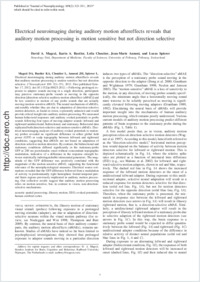Electrical neuroimaging during auditory motion aftereffects reveals that auditory motion processing is motion sensitive but not direction selective
- Magezi, David A. Neurology Unit, Department of Medicine, Faculty of Sciences, University of Fribourg, Switzerland
- Buetler, Karin A. Neurology Unit, Department of Medicine, Faculty of Sciences, University of Fribourg, Switzerland
- Chouiter, Leila Neurology Unit, Department of Medicine, Faculty of Sciences, University of Fribourg, Switzerland
- Annoni, Jean-Marie Neurology Unit, Department of Medicine, Faculty of Sciences, University of Fribourg, Switzerland
- Spierer, Lucas Neurology Unit, Department of Medicine, Faculty of Sciences, University of Fribourg, Switzerland
-
17.10.2012
Published in:
- Journal of Neurophysiology. - 2013, vol. 109, no. 2, p. 321-331
English
Following prolonged exposure to adaptor sounds moving in a single direction, participants may perceive stationary-probe sounds as moving in the opposite direction [direction-selective auditory motion aftereffect (aMAE)] and be less sensitive to motion of any probe sounds that are actually moving (motion-sensitive aMAE). The neural mechanisms of aMAEs, and notably whether they are due to adaptation of direction-selective motion detectors, as found in vision, is presently unknown and would provide critical insight into auditory motion processing. We measured human behavioral responses and auditory evoked potentials to probe sounds following four types of moving-adaptor sounds: leftward and rightward unidirectional, bidirectional, and stationary. Behavioral data replicated both direction-selective and motion-sensitive aMAEs. Electrical neuroimaging analyses of auditory evoked potentials to stationary probes revealed no significant difference in either global field power (GFP) or scalp topography between leftward and rightward conditions, suggesting that aMAEs are not based on adaptation of direction-selective motion detectors. By contrast, the bidirectional and stationary conditions differed significantly in the stationary-probe GFP at 200 ms poststimulus onset without concomitant topographic modulation, indicative of a difference in the response strength between statistically indistinguishable intracranial generators. The magnitude of this GFP difference was positively correlated with the magnitude of the motion-sensitive aMAE, supporting the functional relevance of the neurophysiological measures. Electrical source estimations revealed that the GFP difference followed from a modulation of activity in predominantly right hemisphere frontal-temporal-parietal brain regions previously implicated in auditory motion processing. Our collective results suggest that auditory motion processing relies on motion-sensitive, but, in contrast to vision, non-direction-selective mechanisms.
- Faculty
- Faculté des sciences et de médecine
- Department
- Médecine 3ème année
- Language
-
- English
- Classification
- Biological sciences
- Other electronic version
- License
- License undefined
- Identifiers
-
- RERO DOC 31939
- Persistent URL
- https://folia.unifr.ch/unifr/documents/303035
Statistics
Document views: 69
File downloads:
- spi_end.pdf: 141
